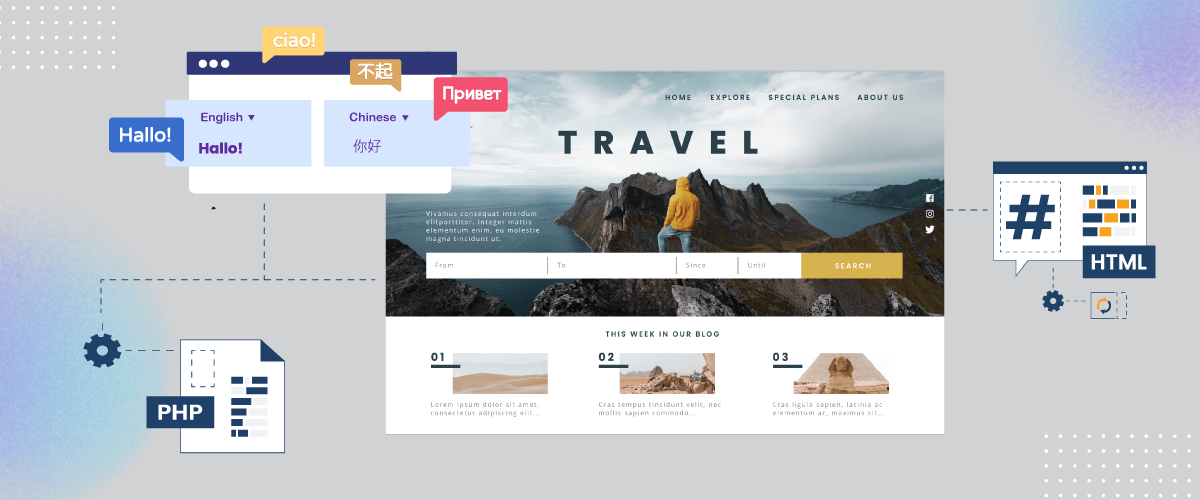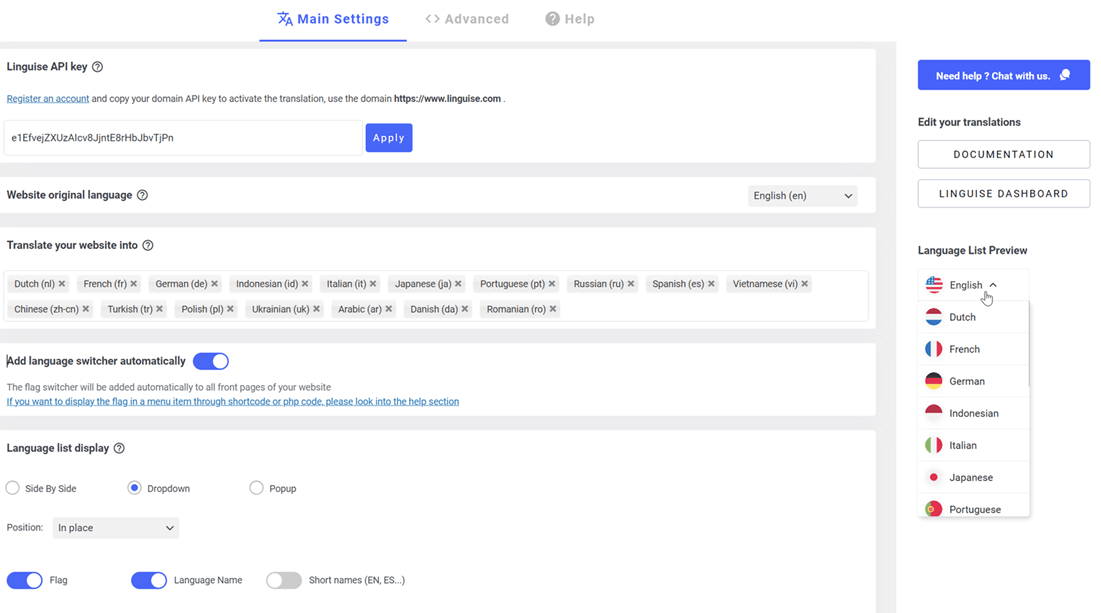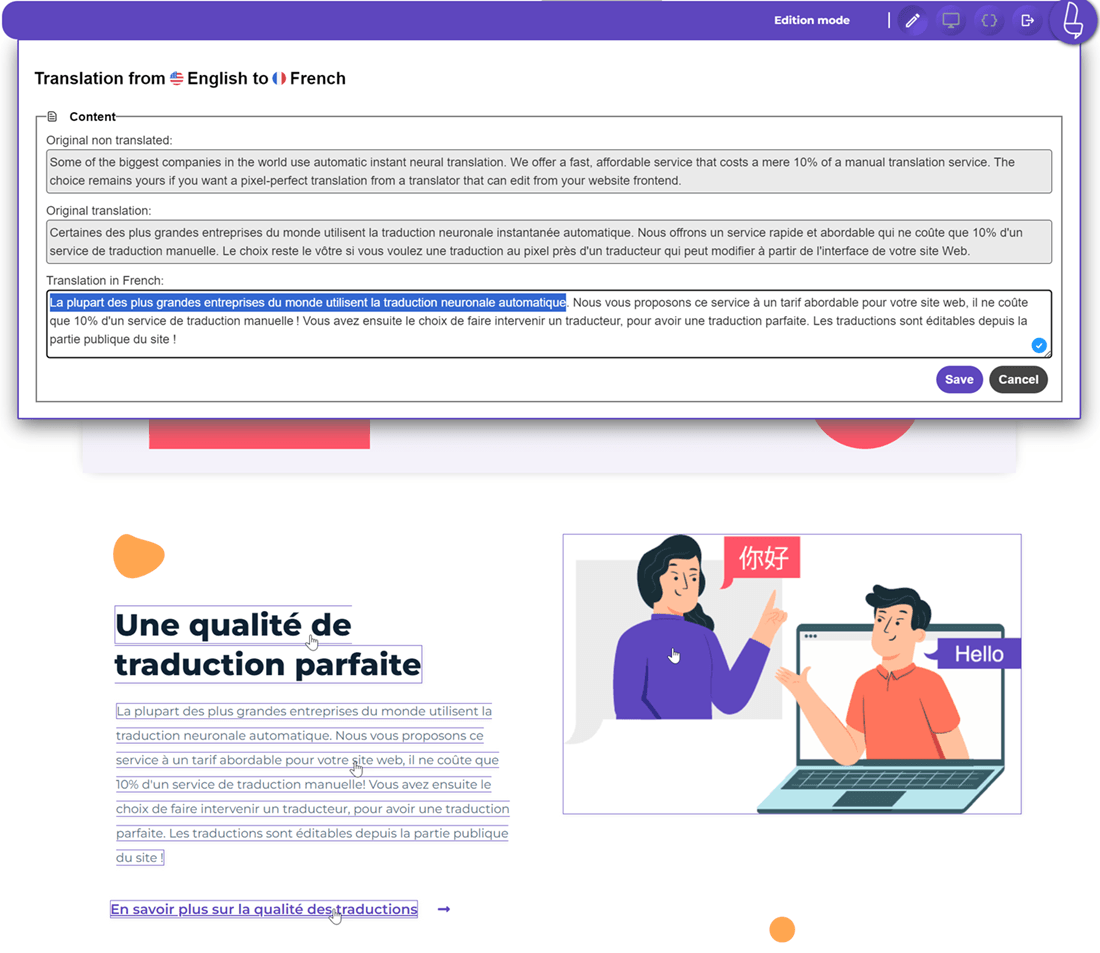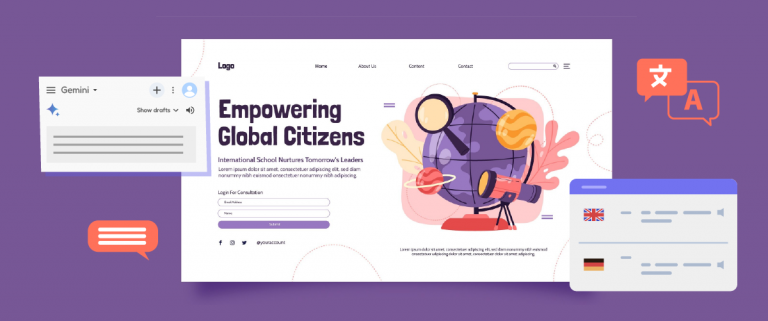Translation testing plays an important role in ensuring the accuracy and quality of translated content.
From verifying the accuracy of translated text to ensuring proper formatting and functionality, thorough testing is essential to delivering a smooth multilingual website.
To ensure accuracy and consistency between languages, there are key checks that need to be performed. So, in this article we will discuss the importance of translation tests, what should be checked, and tips for ensuring translation accuracy.
What’s the purpose of the translation test?
The goal of translation testing for a multilingual website is to ensure that the translated content accurately conveys the intended message and provides a seamless user experience across multiple languages.
Specifically, translation testing has the following objectives in the context of a multilingual website.
- Accuracy: Testing aims to verify the accuracy of the translated content, ensuring that the content faithfully represents the original text in each language.
- Consistency: Ensure consistency in terminology, style, and tone across all translated versions of the website. This helps maintain a cohesive brand identity and user experience for visitors, regardless of the language they speak.
- Functionality: Apart from linguistic accuracy, testing also verifies the authenticity of the translated website. This ensures that all links, buttons, forms, and interactive elements function properly in every language, providing a smooth and seamless browsing experience.
- User experience: Experience the overall user experience of a multilingual website. It checks the readability, clarity, and usability of translated content, ensuring that visitors can easily navigate, understand, and interact with the website regardless of their language preference.
4 keys you must check in translation testing
There are various components involved in localizing a translation, here are some things you should check when testing a translation, including the following.
Pre translation testing
The first key is pre-translation testing, which involves reviewing the source text and preparing it before translation. This step ensures that the source text is clear, concise, and free from errors or inconsistencies that could affect the translation process.
This step ensures that the original text is functioning correctly to prevent repeated errors, which would later require additional effort and resources to correct.
For example, before translating a company website into another language, review the original English text for clarity, especially in important sections such as ‘About Us’ and service descriptions. This ensures the source material is free from ambiguity or error.
By ensuring the clarity of the original text before the translation process begins, companies can minimize the risk of translation errors. This helps in conveying the company message appropriately to the target audience in a language they understand.
Key tips: ensure the original text before the translation process begins to minimize the risk of translation errors. This helps in conveying the company message appropriately to the target audience in a language they understand.
Accuracy linguistics
The second key is linguistic accuracy, which focuses on verifying the linguistic aspects of the translation. This includes checking grammar, syntax, vocabulary usage, and overall alignment to ensure that the translated content accurately conveys the intended meaning of the source text. Linguistic accuracy is critical to maintaining the integrity and effectiveness of the translation.
If you also hire a professional translator, they must ensure that the localized content can accurately convey the meaning and intent contained in the original text.
For example, a business wants its brand name to remain default and not be translated, because if it is translated the meaning will be different or even strange and not appropriate to the business context.
Key tips: at this point what you must check is the page content including title, content and the naming of menus.
Functional testing
Functional testing includes verifying that all links work properly, forms fill out correctly, and interactive features work as intended. This will ensure that users can interact with the website smoothly in their preferred language.
Next, ensure that translated content displays correctly across browsers, devices, and screen resolutions. Translated websites should look and function well on multiple platforms, such as desktop computers, tablets, and smartphones.
Then, this step also includes checking for formatting problems, excessive use of spaces, word repetition, and inconsistencies in capitalization (for example, differences in capitalization between sentences and titles in the header).
For example, on an e-commerce site, make sure product descriptions and checkout processes work smoothly in the translated version, or a website that provides a form such as registration must ensure that each sentence is translated clearly and accurately so that all visitors can fill it out.
As in one of the checkout page views translated into French.
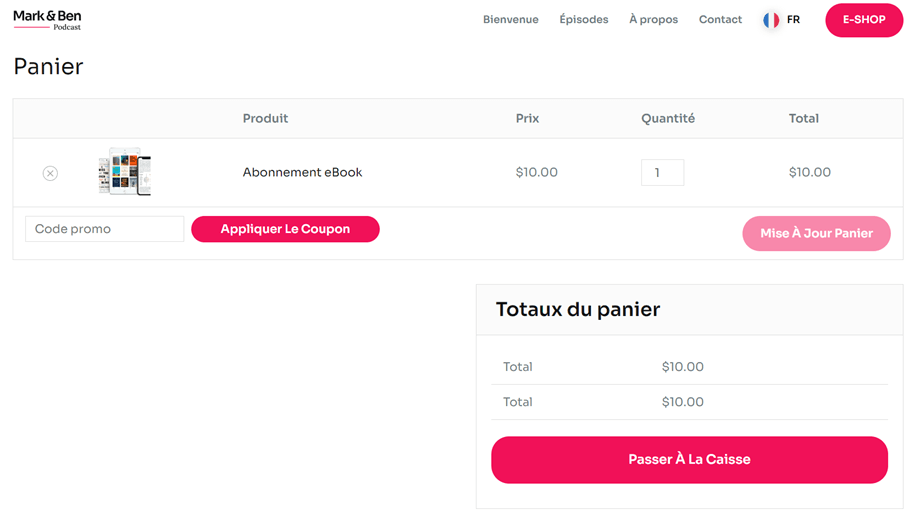
Key tips: in the functional section of the test, several things must be checked on the website such as registration forms, media and URL links (external and internal), language switcher for switching languages, and various other elements that relate directly to the user.
Then when translating to another language, ensure that elements such as search on the website work properly, for example on an online job portal, verify that the search filters, application form and resume upload function work correctly without formatting errors or text overflow, especially when switching between one language to another.
Visual testing
Changes to typeface, text length, and text orientation can impact the visual experience. You should also pay attention to the layout, amount of content, ease of use, and comfort of interface elements with user preferences. In addition, it is also important to consider their emotional responses, such as perceived comfort with the user interface, as this can have a significant impact on product conversion rates.
Key tips: what you have to check regarding visual testing is starting from the use of images, content layout, menus, and consistent content writing.
8 Tips to ensure translation accuracy and reliable results
To ensure good translation and reliable results, there are several tips you can follow.
Establish clear translation requirements
It is important to establish clear translation requirements. First, clearly define the project scope, target audience, goals, and desired style. Provide a style guide and specific instructions for consistency. Also, discuss relevant cultural nuances.
With clear translation requirements, a comprehensive style guide, and attention to cultural nuances, translations will be more accurate and tailored to your needs.
Check things that related to the brand
The next tip is to make sure things related to your brand or business have been checked, for example, the brand name. Generally, on multilingual sites, the brand name will not be translated, meaning it is left default as is.
When testing a translation, check whether it is translated or not. To exclude text such as brand names, or other technical text. You can use the exception translation feature, which means ignoring text rules.
This will help your brand name remain original, and other technical insights will also not be translated. Instead of being doubtful about the translation results and the potential for translation errors, it is better to just exclude it and leave it as the default.
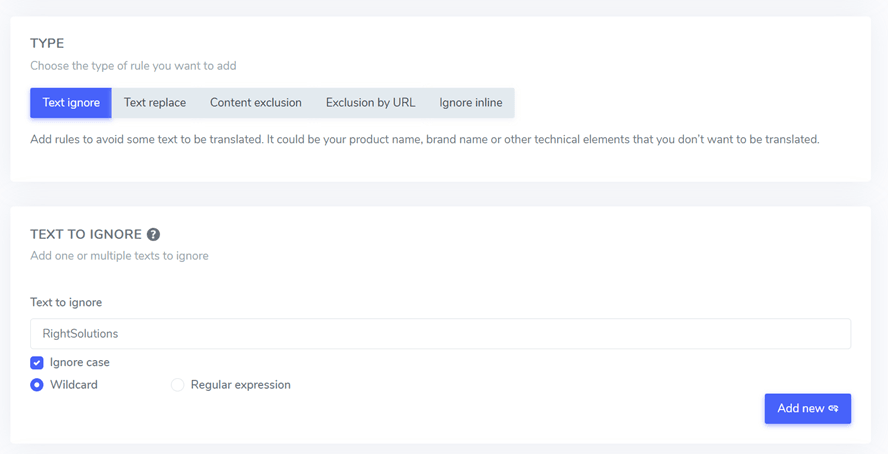
Collaborate with professional translators
Machine translation is not enough to obtain high-accuracy translation results, especially translations that have strong cultural nuances to the target language. All the results are still less than natural, therefore collaborating with a translator is the right step.
Choose a translator who is experienced in the language and is suitable. Provide context and references to the translator to ensure a proper understanding of your business.
You can invite translators to your website dashboard to translate shared content. The front-end live editor feature allows translators to improve existing translations or translate original content.
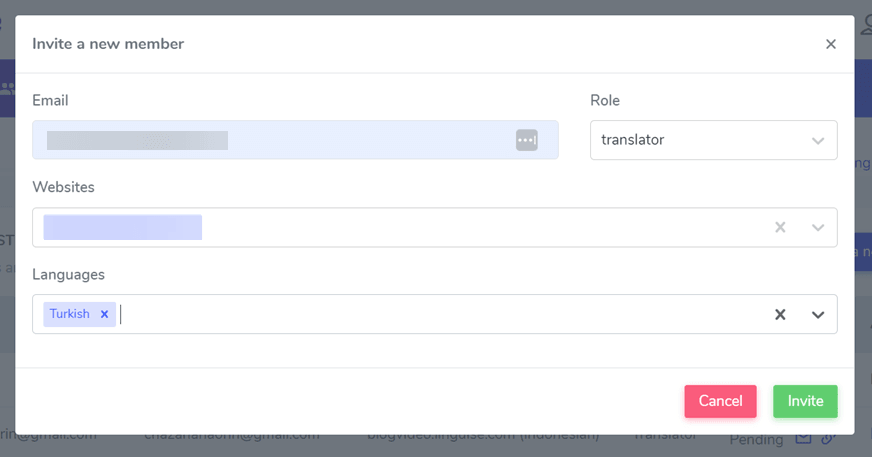
Conduct a bilingual examination
Translation tests need to involve bilingual tests, i.e. where the translated text is compared with the original text. If you use a translator, make sure they have a deep understanding of your product and brand to ensure that the localized content stays true to the intent of the original text.
Conduct user testing and ask for feedback
The next tip is to do user testing. By conducting user testing, you can test the effectiveness and understanding of the translation by the target audience.
Then by asking for feedback, you can gain valuable insight into the success of the translation and areas that need improvement. Combining user testing and feedback allows you to produce translations that are better, more relevant, and better suited to user needs.
Test localization elements
Testing local elements is also one of the things that needs to be done. Make sure translation elements such as dates, currency, units of measurement, and localized images are appropriately adapted to the target language and culture.
Test the functionality of localized features, such as localized search function, and currency conversion.
For example, on an eCommerce site, it is important to translate the checkout page correctly. To make the process easier, you should make sure to use a translation plugin that can translate all pages including the checkout page.
Imagine a customer who has added items to a cart and proceeds to the checkout page on an eCommerce website. If the checkout page is not translated correctly, customers may have difficulty understanding instructions, payment options, or shipping details.
By using a translation plugin that can accurately translate all pages, including checkout pages, you can ensure that customers from various language backgrounds can easily understand the information presented to them.
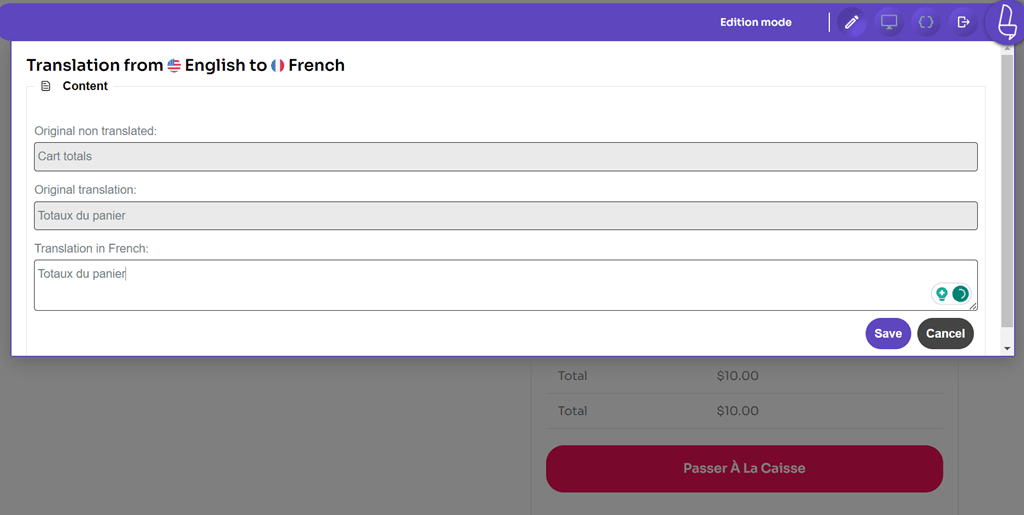
Location elements and easy navigation
Navigating the website easily is also one of the tips for producing accurate translations, one of which is related to the language switch element.
The language switcher element is something that must be present so that users can switch languages, make sure to place the language switcher in an easy-to-reach position and provide attractive and clear customization.
You can designing the language selector according to website needs, starting from customizing colors, and icons, to the position. Apart from language-switching elements such as images, links, and links, which will be directly related to visitors, make sure they are translated well and easy to understand.
Review and update regularly
Regular translation updates are essential to maintain content accuracy and relevance. In the translation process, it is necessary to continuously update the translation in accordance with changes in the source language or other translation needs. By updating your translations regularly, you can avoid outdated or inaccurate information.
When updating content, you should check the entire content through the front end of the website. If any changes need to be made, you can use the live editor feature which will immediately change the translation.
Additionally, we also provide guidance to ensure your website elements are translated including menus item, URL translation management, and link & image translation
Implementing translation tool
The final tip is to use a translation tool. Translation tools can help harmonize the translation process by providing automated features that speed up translation time.
Next, ensure the tool can be seamlessly integrated into your testing workflow. Check whether the tool can work with the software or platform you are using. Additionally, take into account the tool’s ability to collaborate with translators and facilitate efficient workflows.
By implementing the right translation tools you can increase productivity, improve translation accuracy, and reduce wasted effort in the translation process.
Linguise guarantees effective translation
As we discussed previously, one tip to ensure translation accuracy is to use a translation tool, one of which is Linguise.
Linguise is an automatic AI translation solution specifically for website localization. It offers comprehensive features that make the translation process efficient and effective.
One of Linguise’s key features is its AI-powered translation engine. Using an advanced, cloud-based AI translation, Linguise can accurately translate website content in real-time.
With Linguise, website managers and content creators can easily manage and update translations, eliminating the need for complex coding or outsourcing to translation agencies.
Linguise is an effective translation tool because it offers the following.
- Automatic content detection – Linguise can automatically detect content on websites and translate it in real-time. This allows content changes to be immediately visible in multiple languages and no content will be missed.
- Up to 97% translation quality – By using an artificial intelligence (AI) based translation engine, Linguise offers perfect translation quality. We have tested and the results show that Linguise can achieve a translation accuracy rate of up to 97%. You only need to perfect the remaining 3%.
- Translator addition support – Linguise allows the setup translator access to check and validate translations. You can add any number of translators to the Linguise dashboard, this helps ensure more accurate and quality translations.
- Instant update translations – With Linguise, translation updates can be done instantly. When there are changes to the original content, the translation will be updated automatically, saving the time and effort of manually updating the translation.
- Integrates with various platforms – Linguise can work on various website platforms or CMS such as WordPress, Joomla, Shopify, and integrates more than 40 other platforms. With Linguise’s integration capabilities, you can achieve localization efforts and efficiently manage translations across multiple platforms,
- Centralized translation management – Linguise offers a failed translation management platform. It allows users to easily manage and organize translations in one place. This makes coordination easier and ensures translation consistency across websites.
- Translation exclusion rules – Want content not to be translated? You can use exclusion rules, several types can be used, such as URL-based, line-based, and text-based.
- Live editor translation – Don’t just rely on machine translation, for guaranteed accurate results, you can use the front-end live editor Linguise. This feature allows admins and translators to translate and edit directly on the front page of the website.
Get accurate website translations with Linguise!
In conclusion, when it comes to testing translations for a multilingual website, the ultimate goal is to ensure accurate and consistent content delivery in multiple languages. This can be achieved by conducting thorough testing, including pre-translation testing and visual testing, which play crucial roles in guaranteeing translation accuracy and consistency.
To further enhance the translation process, following best practices, such as utilizing a translation tool, is highly recommended. Implementing a tool like Linguise can greatly simplify the translation process and provide users with various advanced features.
If you are seeking high translation accuracy based on AI Translation Cloud, registering for a free Linguise account is highly recommended. With Linguise, you can benefit from an outstanding translation accuracy rate of up to 97% and take advantage of features like the live editor, instant updates, and the ability to add translators to further strengthen your web translation results.
By leveraging Linguise, you can streamline the translation process and ensure that your multilingual website effectively communicates with a global audience.

